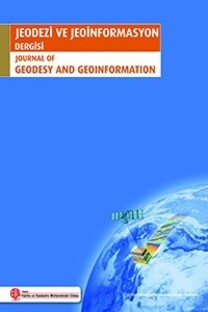Hava Lidar verilerinin denetimsiz yapay sinir ağları kullanılarak filtrelenmesi
Lidar, Yapay sinir ağları, Kendini düzenleyen haritalar, Filtreleme
Filtering of airborne Lidar data by using unsupervised artificial neural networks
Lidar, Artificial neural networks, Self organizing maps, Filtering,
___
- Briese, C. (2010). Extraction of digital terrain models. Vosselman, G., & Maas, H.-G.(ed) Airborne and terrestrial laser scanning (s.135–167). Dunbeath, UK: Whittles Publishing.
- Chen, Q., Wang, H., Zhang, H., Sun, M., & Liu, X. (2016). A point cloud filtering approach to generating DTMs for steep mountainous areas and adjacent residential areas. Remote sensing, 8(1), 71.
- Chen, Z., Gao, B., & Devereux, B. (2017). State-of-the-art: DTM generation using airborne LIDAR data. Sensors, 17(1), 150.
- Giampouras, P., Charou, E., & Kesidis, A. (2013). Artificial Neural Network Approach for Land Cover Classification of Fused Hyperspectral and Lidar Data. Papadopoulos, H.,
- Andreou, A.S., Iliadis, L., & Maglogiannis, I.(ed) IFIP International Conference on Artificial Intelligence Applications and Innovations (s. 255-261). Berlin, Heidelberg: Springer.
- Grebby, S., Naden, J., Cunningham, D., & Tansey, K. (2011). Integrating airborne multispectral imagery and airborne LiDAR data for enhanced lithological mapping in vegetated terrain. Remote Sensing of Environment, 115(1), 214-226.
- Kang, X., Liu, J., & Lin, X. (2014). Streaming progressive TIN densification filter for airborne LiDAR point clouds using multi-core architectures. Remote sensing, 6(8), 7212-7232.
- Kayı, A., Erdoğan, M., & Eker, O. (2015). OPTECH HA-500 ve RIEGL LMS-Q1560 ile gerçekleştirilen LİDAR test sonuçları. Harita Dergisi, 153(2), 42-46.
- Kohonen, T. (1990). The Self-Organizing Map. Proceedings of the IEEE, 78, 1464-1480.
- Kohonen, T. (2001). Self-organizing maps. Berlin, Almanya: Springer.
- Kwon, S. K., Jung, H. S., Baek, W. K., & Kim, D. (2017). Classification of forest vertical structure in south Korea from aerial orthophoto and lidar data using an artificial neural network. Applied Sciences, 7(10), 1046.
- Mongus, D., & Žalik, B. (2014). Computationally efficient method for the generation of a digital terrain model from airborne LiDAR data using connected operators. IEEE journal of selected topics in applied earth observations and remote sensing, 7(1), 340-351.
- Morris, J. T., Porter, D., Neet, M., Noble, P. A., Schmidt, L., Lapine, L. A., & Jensen, J. R. (2005). Integrating LIDAR elevation data, multi‐spectral imagery and neural network modelling for marsh characterization. International Journal of Remote Sensing, 26(23), 5221-5234.
- Salah, M., Trinder, J., & Shaker, A. (2009). Evaluation of the self‐organizing map classifier for building detection from lidar data and multispectral aerial images. Journal of Spatial Science, 54(2), 15-34.
- Şen, A., Süleymanoğlu, B., & Soycan, M. (2020). Unsupervised extraction of urban features from airborne lidar data by using self-organizing maps. Survey Review, 52(371), 150-158.
- Sithole, G., & Vosselman, G. (2003). Report: ISPRS Comparison of Filters. Commission III, Working Group 3. https://www.itc.nl/isprs/wgIII-3/filtertest/report05082003.pdf.
- Sithole, G., & Vosselman, G. (2004). Experimental comparison of filter algorithms for bare-Earth extraction from airborne laser scanning point clouds. ISPRS journal of photogrammetry and remote sensing, 59(1-2), 85-101.
- Skupin, A., & Agarwal, P. (2008). Introduction: What is a Self-Organizing Map? Agarwal, P., & Skupin, A.(ed) Self-organising maps: Applications in geographic information science (s. 1-20). Chichester, UK: John Wiley & Sons.
- Yan, J., & Thill, J.-C. (2008). Visual exploration of spatial interaction data with self-organizing maps. Agarwal, P., & Skupin, A.(ed) Self-organising maps: Applications in geographic information science (s. 67-85). Chichester, UK: John Wiley & Sons.
- Zaletnyik, P., Laky, S., & Toth, C. (2010). LiDAR waveform classification using self-organizing map. ASPRS, 28-30.
- Zhang, J., Lin, X., & Ning, X. (2013). SVM-based classification of segmented airborne LiDAR point clouds in urban areas. Remote Sensing, 5(8), 3749-3775.
- ISSN: 2147-1339
- Yayın Aralığı: Yılda 2 Sayı
- Başlangıç: 2012
- Yayıncı: TMMOB Harita ve Kadastro Mühendisleri Odası
Ömer GÖKDAŞ, Mustafa Tevfik ÖZLÜDEMİR
Çoklu-GNSS çözümlerinin performansının internet tabanlı Trimble RTX servisi ile incelenmesi
Gizem SEZER, Ali Hasan DOĞAN, Bahattin ERDOĞAN
Münevver Gizem GÜMÜŞ, S. Savaş DURDURAN
Hava Lidar verilerinin denetimsiz yapay sinir ağları kullanılarak filtrelenmesi
Web tabanlı CSRS-PPP uygulamasının farklı uydu sistemleri üzerindeki performansı
Türkiye denizlerinde GNSS reflektometre tekniği ile deniz seviyesi değişiminin araştırılması
